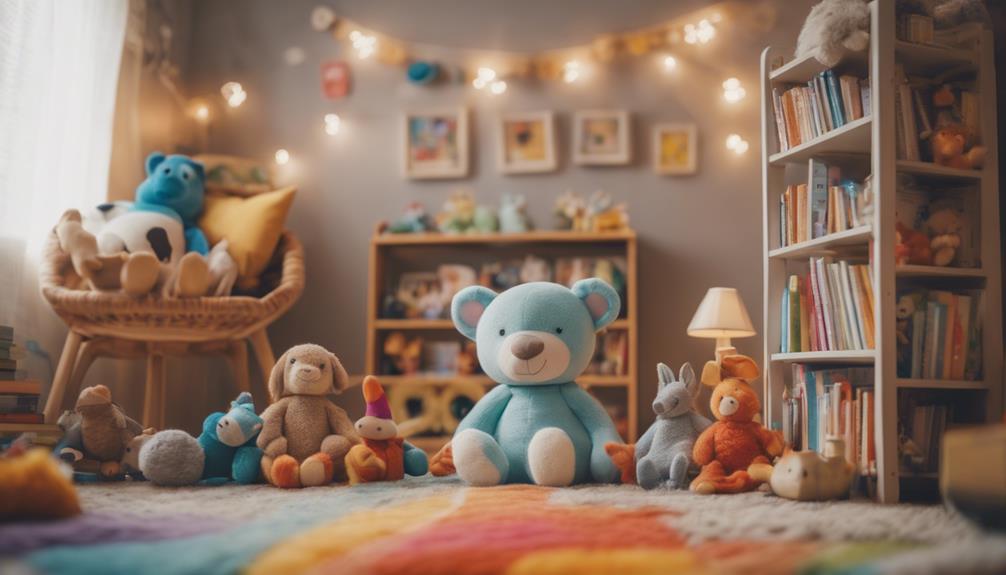In order to prevent flat head syndrome in your baby, it is important to incorporate supervised tummy time every day to help strengthen neck muscles and promote healthy skull development. Make sure to place your baby on their back while sleeping and alternate head positions to evenly distribute pressure and decrease the chances of flat spots. Utilizing different carrying positions like the football hold can also help prevent flat head syndrome. Following these crucial tips can aid in averting flat spots and maintaining proper head positioning for your baby. Embracing these recommendations will contribute to your baby’s overall growth and development. Additional information on preventing flat head syndrome can be found here.
Key Takeaways
- Supervised tummy time daily strengthens neck muscles.
- Use firm mattress and safe bedding for sleep.
- Vary carrying positions to distribute pressure evenly.
- Incorporate side-lying play activities for head movement.
- Regularly change baby's positions throughout the day.
Importance of Preventing Flat Head
Preventing flat head in babies is essential for ensuring healthy head shape development. Supervised tummy time is a vital activity that aids in strengthening your baby's neck muscles, reducing the likelihood of developing a flat head. By engaging in supervised tummy time sessions, you help your baby build the necessary strength in their neck and shoulder muscles, which supports proper head positioning.
Early intervention and preventive measures are key in safeguarding your baby's head shape from flat spots that could lead to long-term issues. Varying sleeping positions, holding your baby frequently, and ensuring they spend minimal time in devices like car seats or bouncers also contribute to preventing flat head syndrome.
Head Positioning During Sleep
To ensure proper head shape development and prevent flat spots, paying attention to your baby's head positioning during sleep is essential. Placing your baby on their back is important to reduce the risk of flat head syndrome and prevent SIDS. Alternating their head position while lying on their backs can help distribute pressure evenly and maintain the roundness of their head shape. Using a firm mattress and avoiding soft bedding further minimizes the risk of flat spots forming during sleep. Regularly checking and adjusting your baby's head position can also contribute to ensuring their head shape develops properly. Implementing a consistent sleep routine and creating a safe sleep environment are crucial aspects of preventing flat head syndrome. Below is a table summarizing key points about head positioning during sleep:
| Key Points | Importance |
|---|---|
| Placing baby on their back | Reduces the risk of flat head syndrome and prevents SIDS |
| Alternating head position | Helps distribute pressure evenly and maintain head shape |
| Using firm mattress and safe bedding | Minimizes the risk of flat spots forming during sleep |
Incorporating Tummy Time

Incorporate at least 30 minutes of supervised tummy time daily to help strengthen your baby's neck and shoulder muscles. Tummy time is vital for infant development as it encourages natural head movement, preventing flat spots on the back of the baby's head.
Through supervised tummy time sessions, your baby won't only build neck and shoulder muscles but also develop the necessary strength for better head control. Regular tummy time also aids in sensory and visual development, contributing to overall motor skills enhancement.
By engaging in tummy time, you're actively reducing the risk of flat head syndrome and promoting healthy skull development in your little one. Remember that tummy time should always be monitored to ensure your baby's safety.
Side-Lying Play Activities

Engage your baby in side-lying play activities to promote head movement and relieve pressure on the back of their head. By incorporating colorful toys and objects strategically around your baby as they lie on their side, you can stimulate their head movement and prevent flat spots from forming.
These activities not only encourage the baby's head to move naturally but also help in distributing pressure evenly on their skull, reducing the risk of developing flat areas.
Side-lying play can be integrated into your baby's routine during supervised tummy time sessions, aiding in the promotion of muscle development in their neck and shoulders. Alternating side-lying play with other interactive activities not only keeps your baby engaged but also ensures a well-rounded approach to preventing flat head syndrome.
Varying Carrying Positions

Utilize different carrying positions to help distribute pressure on your baby's skull and prevent flat spots from forming. Carrying your baby in the football hold or side-lying position can alleviate consistent pressure on the same areas of the head. By changing arms daily while carrying your baby, you can guarantee that the pressure is evenly distributed, reducing the risk of flat spots.
Strategic placement of toys during playtime can encourage your baby's head movement, preventing prolonged pressure on specific areas of the skull. Supervising your baby during tummy time and alternating sides when carrying them are vital steps in avoiding flat spots on the head. Additionally, limiting the extended use of car seats and bouncers can also help prevent the development of flat spots on your baby's delicate skull.
Seeking Early Intervention

When it comes to preventing flat head syndrome, seeking early intervention is key.
Timely professional assessment can guide you towards corrective measures tailored to your baby's needs.
Timely Professional Assessment
Seeking early professional assessment from a healthcare provider is essential for promptly addressing flat head syndrome in infants. Timely detection and intervention play a vital role in managing this condition effectively. Healthcare professionals are equipped to provide valuable guidance on repositioning techniques, physical therapy, and even helmet therapy for severe cases.
Corrective Measures Tailored
For tailored corrective measures addressing flat head syndrome in infants, prompt intervention is essential to guarantee effective management and ideal outcomes. Corrective measures may include repositioning techniques and physical therapy to help correct the baby's head shape.
In severe cases, healthcare providers might recommend helmet therapy to aid in shaping the head properly. Regular monitoring by healthcare professionals is vital to track progress and adjust treatment plans for the best results.
Repositioning the baby's head during sleep and encouraging tummy time are simple yet effective ways to prevent and correct flat head syndrome. Seeking prompt medical advice and intervention is important to address concerns about flat head syndrome early on and ensure proper development of the baby's head.
Encouraging Head Movement

To promote head movement in your baby, utilize toys and noises to capture their attention in different directions. Engaging your baby with colorful and interactive toys won't only entertain them but also stimulate their curiosity to look around, fostering head movement.
Rotate carrying positions frequently and switch arms daily while holding your baby. This practice helps prevent flat spots by encouraging your baby to adjust their head position naturally.
Supervise tummy time sessions closely to confirm your baby is lifting and turning their head while playing with toys. Additionally, incorporate side-lying play with toys to alleviate pressure on the skull and encourage your baby to move their head in different directions.
These activities not only prevent flat spots but also enhance your baby's motor skills and overall development.
Avoiding Prolonged Use of Seats

To prevent flat head syndrome, it's essential to limit the time your baby spends in car seats, swings, or bouncers. By varying positions regularly and encouraging tummy time, you help reduce the pressure on your baby's skull.
Limiting Seat Time
Limiting prolonged use of car seats, swings, and bouncers is essential in preventing flat head syndrome in babies. When babies spend too much time in these devices, uneven pressure on their skull can lead to flat spots.
To help prevent this, consider the following:
- Alternate Positions: Switch between holding your baby and using seats to distribute pressure more evenly on their head.
- Supervised Tummy Time: Encourage supervised tummy time to reduce the risk of flat head syndrome.
- Active Play: Engage in active play and hold your baby upright to help prevent flat spots on their head.
Varying Positions Regularly
Regularly changing your baby's positions throughout the day is crucial in preventing flat head syndrome by reducing prolonged pressure on the skull. When you vary positions, you help distribute weight evenly on the head, decreasing the likelihood of developing a flat spot.
Incorporating activities like side-lying play and supervised tummy time can be beneficial. Avoid prolonged use of seats such as car seats, swings, or bouncers to prevent excessive pressure on one area of the skull.
Alternating between different positions like tummy time, side-lying play, and carrying your baby upright can help avoid prolonged stress on the same spot. By actively engaging in these position changes, you're taking proactive steps towards preventing flat head syndrome in your baby.
Encouraging Tummy Time
Encourage incorporating supervised tummy time sessions into your baby's daily routine to promote healthy head development and prevent flat spots on the skull. Tummy time is crucial to relieve pressure on the back of the head, aiding in the prevention of flat spots. It also assists in the development of neck and shoulder muscles, facilitating healthy head movement and reducing the risk of flat head syndrome. Remember to avoid prolonged use of seats like car seats and bouncers, as they can contribute to skull deformities.
- Supervise tummy time to guarantee safety and proper positioning.
- Alternate carrying positions and engage in side-lying play to distribute pressure on the skull effectively.
- Encourage at least 30 minutes of tummy time daily to support ideal head shape development.
Frequently Asked Questions
How Can I Keep My Baby's Head Round?
To keep your baby's head round, incorporate 30 minutes of supervised tummy time daily, vary sleeping positions, hold and carry your baby frequently, keep them upright while feeding, and limit time in car seats or bouncers.
How Long Does It Take to Prevent a Flat Head?
You might wonder how long it takes to prevent a flat head. It typically requires consistent efforts over several weeks to months. Prioritize daily tummy time, vary sleeping positions, hold your baby frequently, and limit time in car seats or bouncers for best results.
When Is It Too Late to Fix a Flat Head?
If you're wondering when it's too late to fix a flat head, remember that early intervention is key. While it's recommended to start before 6 months, seeking guidance even after can still be beneficial.
How Can I Protect My Baby's Head Shape?
To safeguard your baby's head shape, promote varied sleeping positions, incorporate supervised tummy time for 30 minutes daily, hold and carry your baby frequently, keep them upright while feeding, and limit time in car seats or bouncers.
Conclusion
To summarize, preventing flat head in babies is essential for their overall development and well-being. By following the essential tips outlined, such as proper head positioning during sleep, incorporating tummy time, and varying carrying positions, you can help guarantee your baby's head shape remains healthy and symmetrical.
Remember, a little effort now can go a long way in preventing future complications. So, stay vigilant and proactive in caring for your little one's precious head.









